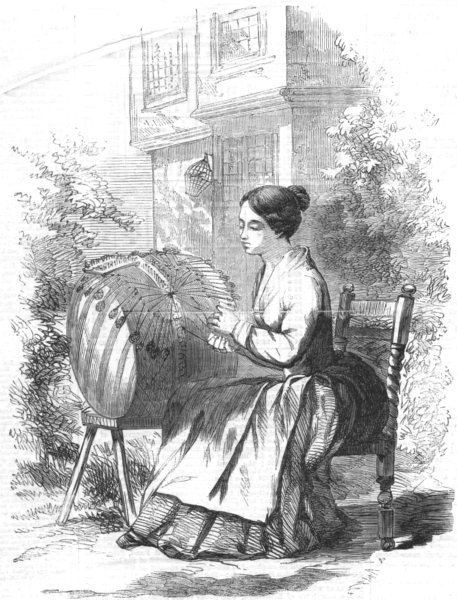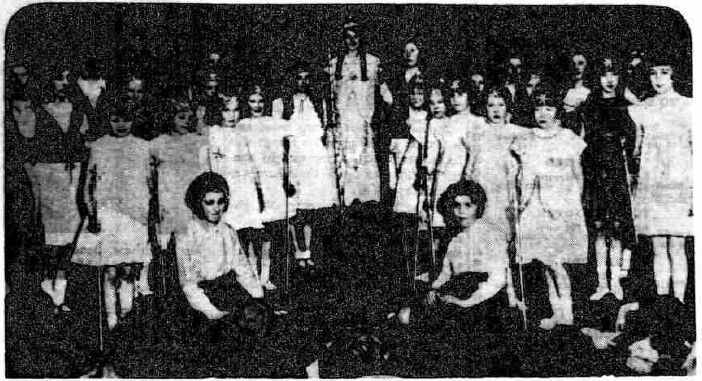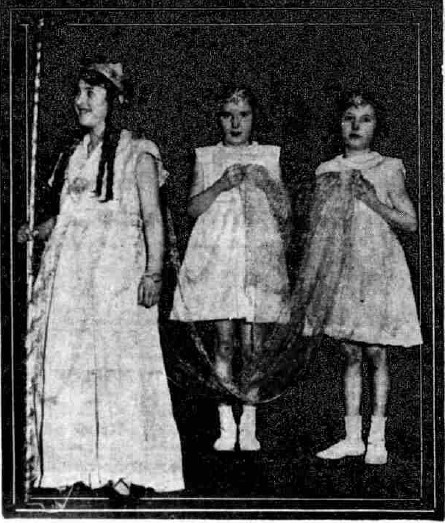One ‘keeps cattern’ but one ’goes tandering’. We are not sure whether this semantic difference is meaningful. Nor are we certain why Saint Andrew became the patron of Midland lacemakers, who celebrated his feast either on ‘new’ (30th November) or ‘old’ (11 December) Saint Andrew’s Day. We know no legend or song that would account for this role similar to those told about Saint or Queen Catherine, and to our knowledge Saint Andrew was not held in particular reverence by any European lacemakers. One Catholic website suggests that it was because the Saint Andrew’s cross resembles intersecting threads… But we suspect that its origins are more ecclesiastical, because Saint Andrew is the patron of many of the churches in the diocese of Peterborough. It seems likely that Tanders was once a widely held village feast and that the association with lacemaking arose as other groups forgot, or were discouraged from, celebrating the saint.

Broughton village sign, featuring its tin can band on Tanders. We borrowed this image from the ‘Broughton Bystander’, and we hope the bystander does not mind.
In some parts of Northamptonshire Tanders was not associated with lacemakers. In Broughton 54 people were bound over to keep the peace in 1930 after a night ‘tandering’, and a further 14 Broughton residents received summons to appear before Kettering magistrates in 1931 for celebrating Tanders too loudly. The crowd, estimated by the police at 1000 strong, had wandered the streets after midnight, banging tin cans and saucepan lids. The background to this mass demonstration was that the Parish Council had banned ‘tandering’, despite an overwhelming local referendum in favour of its maintenance: Saint Andrew being the patron of village church. None of those arrested were lacemakers; in fact there was only one woman among them, a fourteen-year-old ‘tailoress’ who was discharged as too young to be put through the trauma of a magistrates’ court hearing. The local magistrates obviously did not understand the custom, and in 1930 they assumed that this was a form of ‘rough music’ (a type of popular justice used to shame those who had broken the unspoken rules of community life, akin to the ‘Skimmington Ride’ which features in Hardy’s The Mayor of Casterbridge). In 1931 the defendants hired a Northampton lawyer, Mr Burton, who argued, successfully, that Tanders was a traditional custom, always celebrated on the Sunday closest to ‘Old Saint Andrew’s’. The defendants were discharged on the basis that, as the magistrates instructed, ‘nothing of the same kind occurs next year’. However, the revival of Tanders at Broughton continues still with a tin can band and other night-time revels (the website In search of traditional customs and ceremonies has some pictures of the band in action from 2014).
Although widespread across central and southern Northamptonshire and Bedfordshire (some indication of Tanders celebrations, mostly held by lacemakers, have been recorded from Blisworth, Carlton, Cranfield, Elstow, Hanslope, Harrold, Kimbolton (Huntingdonshire), Leighton Buzzard, Milton Malsor, North Crawley, Olney, Pavenham, Stevington, Spratton, Stoke Goldington, Turvey, Wilstead, and Yardley Hastings) the custom passed largely unnoticed until the mid-nineteenth century. The first detailed account we have found so far was provided by Thomas Sternberg in 1851:
Of all the numerous red-letter days which diversified the lives of our ancestors, this is the only one which has survived to our own times in anything like its pristine character. St Andrew appears to be looked upon by the lace-makers as their patron saint; which may perhaps account for the estimation in which his festival is held. In many places, where progress has not yet shown her face, the day is one of unbridled licence – a kind of miniature carnival. Village ‘scholards’ bar out their master; the lace-schools are deserted, and drinking and feasting prevail to a riotous extent. Towards evening the sober villagers appear to have become suddenly smitten with a violent taste for masquerading. Women may be seen walking about in male attire, while men and boys have donned the female dress, and visit each other’s cottages, drinking hot ‘eldern wine,’ the staple beverage of the season. Then commences the Mumming, too often described to need mention here, save to note that in the rude drama performed in the Northamptonshire villages, St George has given place to George III, and the dragon, formerly the greatest attraction of the piece, been supplanted by Napoleon, who is annually killed on this night in personal encounter with the aforesaid monarch, to the intense delight and edification of the loyal audience.
Sternberg’s describes something more boisterous than the ‘cattern teas’ described in our last post, but in many villages the two events passed off in a comparable manner, with ‘washing the candle-block’ the central element. This next description of ‘Tanders’ in Bedfordshire sounds quite like ‘keeping catterns’. It was written by Mrs Kate Leila Edmonds from Summerfield, Carlton… not quite as grand as the Orlebars of Hinwick House who promoted Cattern in Podington over three generations, but still a local mover and shaker, president of the Carlton W.I. after the war, and a promoter of the lace industry. She wrote two extensive accounts of ‘Tanders’ for the Bedfordshire Times and Independent, one in 1900, the second in 1905. We have transcribed the first of these from The British Newspaper Archive. In neither does she give her source, but the memories are not her own; they describe events in the 1850s, whereas Mrs Edmonds was born in 1866. Both descriptions are strongly marked by nostalgia for simpler times of industrious peasants, a sentiment that often characterised attempts to revive the lace-trade:
Fifty years ago, in a little village of Bedfordshire there was great excitement amongst the pupils of the ‘lace school’ one cold November morning. The school dame had no need to scold that day for idleness, or for tardiness in arriving; all had come punctually, and worked with a will. For this was ‘St. Andrews Day,’ or as the lace-makers termed it ‘Tanders’ which brought a half holiday for them all. So the heads were bent over the lace pillows, and the quick fingers picked out the pins and stuck them in again rapidly that a novice would think it looked like play. Ah! but each pupil knew how much she can do in an hour; and she also knew that if she loitered or idled in the least, she could never make up for the lost time. For this lace making cannot be hurried; every stitch must receive the orthodox number of twists and crosses of the bobbins, to make good saleable lace. It was no uncommon thing for the ‘lace buyer’ to take off one half-penny in the yard if a lace was ill-made or not a pure white colour, and this was a consideration of much moment in days when halfpennies were so scarce. Holidays were almost as scarce as half-pennies; hence the unwonted attention of ‘Tanders’ morning fifty years ago. At last the welcome hour of twelve arrived, and one by one the pupils prepare to go home. Bobbins are carefully parted and pushed back each side of the pillow to prevent tangles. The ‘drawer,’ or narrow strip of patchwork is drawn over the lace to keep it spotless; a ‘cover,’ also made of print pieces, is pinned over the lace pillow, and work is over for the day. What a merry time they have! Let us look into one house and see how the lacemakers keep ‘Tanders day.’ The table, chairs, etc., are removed, and the ‘house-place’ cleared; for this is to be no stiff ceremonial party as we shall see. Someone has brought the ‘blades’ of a bobbin wheel, used in non-holiday times to stretch the skein of thread while winding. The ‘blades’ consist of two pieces of wood crossing each other in form like the letter X. The four points of the ‘blades’ being sharpened, a quarter of an apple is stuck on three points, and a piece of tallow candle on the fourth. Now the fun begins; the blades are suspended by a string from the ceiling. one of the party being blind-folded, the hands are tied behind, and as the blades are spun round the blind-folded one has to try to catch in the mouth a piece of apple from one of the points. Great is the fun and delight when, instead of a bite of apple, a bite of candle is taken. But much good temper prevails, and all are willing to take their turn at the ‘snap-apple,’ and so passes the amusement round. But now, the supply of apples being exhausted, and everybody tired of romping, the ‘snap-apple’ is abandoned, and the making of ‘Tanders’ sweets’ begins. These were days when dentists were almost unknown to country folk. Was this due to the fact that sugar was 5d a lb., and sweets regarded as a great luxury for the children? Whether this was so or not, the ‘Tanders’ sweets’ were good and wholesome, and coming only once a year they were in the eyes of the youngsters delicious. Brown sugar, and a very small lump of butter were the ingredients used in making the sweets, and until the boiling process was over everyone was in a state of great excitement and fear, lest the sweets should ‘turn to sugar’ and burn. The boiled sugar being poured on to a floured dish, each one had a hand in rolling or cutting sweets, and putting them by to cool.
The next morning was a trying time to the School Dame. Every lace-maker brought specimen’s of ‘Tander’s sweets’; some burnt black, some sugary, some clear as candy, and all exceedingly sticky. In vain does the School Dame threaten to ‘keep in’ and ‘tell your mother.’ The delinquents still eat sweets and muse on the joys of ‘Tander’s Day,’ thinking dismally what a pity it is that they have to wait a whole year before it comes again. Is it a pity? I think not.

A lacemaker’s bobbin winder from the Pitt Rivers Museum (1911.29.17). It was collected by Percy Manning from Maria Woods of Launton near Bicester (Oxon) in 1894. The blades suggest a St Andrew’s Cross, perhaps the reason for its use in games on Tanders.
Mrs Edmonds’ second article ended with an impassioned plea: ‘Wake up, English lace-makers? Teach your children all you know yourselves, and save the English lace trade from going out of the villages where it has been made for generations.’ Although probably not a lacemaker herself, her description of ‘snap apple’ and ‘Tanders sweets’ tally with other accounts. The reference to a school holiday may account for why lacemakers were among the last celebrators of Saint Andrew’s Day, as they were of St Catherine’s. The lace-school institutionalised memory of these holidays, and gave young lacemakers an incentive to maintain them. Hence the well-known account of ‘barring out’ at Spratton lace school, written in the 1890s but referring to events in the 1850s:
On S. Andrew’s Day they had a curious custom to seize the opportunity of the mistress leaving the room and then lock her out, and on her return they sang,
Pardon Mistress, Pardon Master, Pardon for a pin;
If you won’t give a holiday, We will not let you in.
After a brief display of counterfeited anger the mistress would give way, and the pupils had their half-holiday. The mistress was pretty severe, carrying a cane, and often giving them a cut if they behaved badly, and it is more than likely, says my informant, that they from time to time deserved it.
(The author of this account, which first appeared in Northamptonshire Notes and Queries in 1892, was Margaret Emily Roberts, the daughter of the vicar of Saint Andrew’s, Spratton, a lace teacher and active in the Midland Lace Association.)
Several accounts of Tanders mention a special cake consumed on that day. Pavenham W.I. contributed a recipe for a ‘Tandra cake’ to the 1948 Cookery Book of Traditional Dishes. We have still not tracked this down, but in the meantime here is Julia Jones’ and Barbara Deer’s recipe for a St Andrew’s Cake from Cattern Cakes and Lace. A Calendar of Feasts:
Ingredients
- 1lb/450g plain flour
- 1 teaspoon salt
- ½ oz/15 g fresh or ½ tablespoon dried yeast
- 1 teaspoon caster sugar
- ½ pint/300 ml warm water
- 1 egg beaten
- 4oz/100g lard, melted
- 4oz/100g currants
- 4oz/100 g sugar
- 1 oz diced crystallized lemon peel
Instructions
- Oven 180 degrees C.
- Sift the flour and salt into a bowl.
- Cream the yeast with the teaspoon of sugar and blend in the water.
- Leave the yeast to froth and bubble, then mix with the beaten egg and add to the flour.
- Pour in the cooled, melted lard, and mix until smooth.
- Knead well, cover and leave to double in size.
- Knock back the dough and knead in the currants, sugar, and peel.
- Transfer to a greased 2lb/1kg loaf tin.
- Leave to rise until the dough reaches the top of the tin. 20-30 mins.
- Then back to oven for 60-70 mins until well risen and golden.
- Cool on a wire rack.
- Slice and serve with butter.
Sources
Anne Elizabeth Baker, Glossary of Northamptonshire Words and Phrases, With Examples of their Colloquial Use, And Illustrations from Various Authors: To Which are Added, the Customs of the County (London: John Russell Smith, 1854).
Kate Leila Edmonds, ‘The Lace Makers’ Patron Saint. Fifty Years Ago’, Bedfordshire Times and Independent, 16 February 1900.
Kate Leila Edmonds, ‘St. Andrew’s Day or “Tanders”,’ Bedfordshire Times and Independent, 24 November, 1905.
Rev. E.R. Grant (Unitarian minister of Northampton), text of talk given on ‘The Legends and Folk-Lore of Northamptonshire’ at Northampton Town Hall, reported in the Northampton Mercury, 13 March 1880.
Dorothy Grimes, Like Dew Before the Sun. Life and Language in Northamptonshire (Northampton: Dorothy Grimes, 1991).
Julia Jones and Barbara Deer, Cattern Cakes and Lace: A Calendar of Feasts (London: Dorling Kindersley, 1987).
‘M.E.R’ [Margaret Emily Roberts], ‘Spratton Lace School’, Northamptonshire Notes and Queries, 4, 1892.
‘Tin Can Band in Court: Broughton Mummers who Celebrated “Tander”,’ Northampton Mercury, 2 January 1931.
Thomas Sternberg, The Dialect and Folk-Lore of Northamptonshire (London & Northampton: John Russell Smith, 1851).
Thomas Wright, The Romance of the Lace Pillow (Olney: H.H. Armstrong, 1919).















